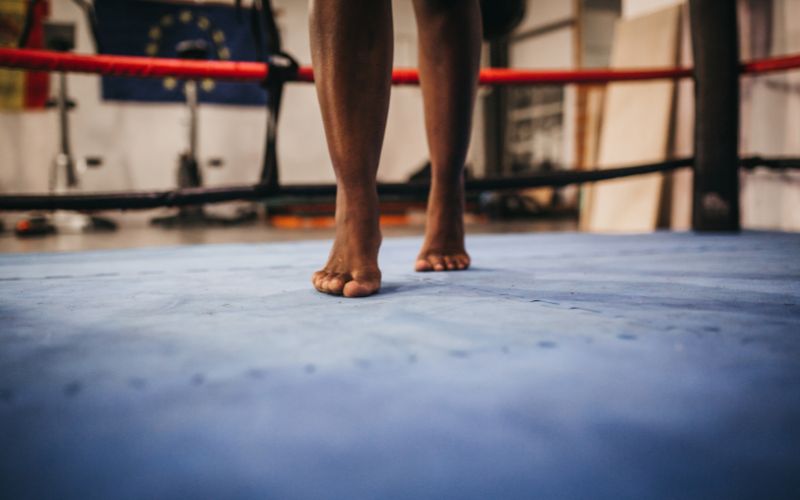The art of boxing requires not only strength and power but also agility and quick reflexes. A crucial factor that influences a boxer’s performance in the ring is their footwork. This leads us to the question: Why is it bad to be flat footed in boxing?
Being flat footed in boxing refers to a lack of mobility, often resulting in slower responses and reduced defensive capabilities. Although this stance can provide greater power and stability for punches, it can leave a boxer vulnerable to counterattacks due to decreased agility.
While being flat footed in boxing can sometimes slow you down and make you an easy target, it’s not always a bad thing. In fact, how you use your feet can change how well you do in different situations.
As we look more closely at footwork in boxing, we’ll talk about how being on your toes and being flat footed can both be good or bad, depending on what’s happening in the ring. We’ll look at questions like: Should your heels touch the ground? Should your feet be planted when punching? By understanding these parts of boxing, you’ll see that being flat footed can sometimes be a good strategy, not just a weakness.
Being Flat Footed vs Having Flat Feet
The terminology can be a tad confusing, but being flat footed and having flat feet are not the same thing, especially when it comes to boxing. These are two different terms with different implications for performance in the ring.
Being Flat Footed in Boxing
Being flat footed in boxing does not refer to a medical condition but rather to a boxer’s stance and movement. Boxers who are described as “flat footed” are those who tend to stay on the flat parts of their feet, rather than remaining on their toes. This reduces their agility and maneuverability in the ring, making it harder for them to move swiftly, dodge punches, or launch quick counter-attacks.
A flat footed stance in boxing could signify a more power-driven fighting style, where the boxer is ready to plant their feet and land heavy blows. However, the downside is that they become less reactive and slower in dodging punches, which could leave them vulnerable to their opponent’s strikes. It’s not that being flat footed is always a bad thing, it simply requires different strategies and tactics in the ring.
Having Flat Feet as a Medical Condition
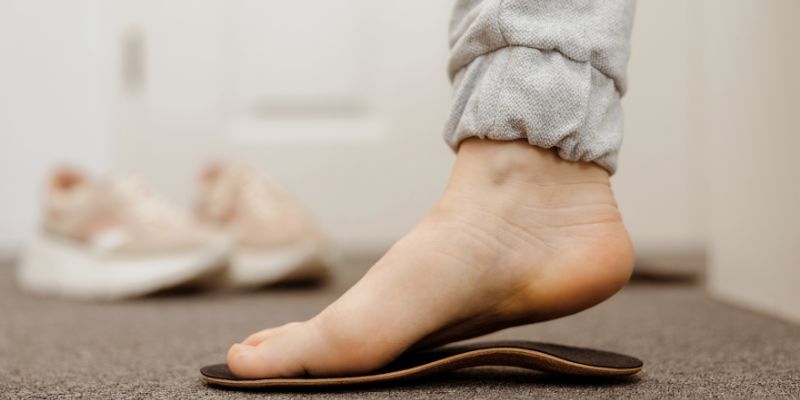
On the other hand, flat feet, or pes planus, is a medical condition. This is when one or both feet do not have normal arches, causing the feet to lie completely flat on the ground. This can affect a person’s balance, stability, and even the alignment of their legs and back. It can also lead to discomfort or pain, especially after extended physical activity.
In the context of boxing, flat feet could potentially pose challenges due to these balance and stability issues. It could affect a boxer’s footwork, an essential component of a good boxing technique. Yet, it does not outright preclude success in the ring. With the right support and specialized training, individuals with flat feet can definitely excel in boxing.
If you have flat feet and are interested in boxing, it’s recommended to consult a medical professional or a physical therapist. They can help address any potential issues associated with flat feet and devise a tailored training plan that takes into account your specific needs and limitations. It’s all about adapting and finding ways to use what you have to your advantage, rather than viewing it as a disadvantage.
Flat Footed vs On Toes In The Ring
Understanding the pros and cons of being flat footed versus being on your toes is essential for a boxer. These differing stances can vastly influence the dynamics of a fight, affecting a boxer’s power, speed, defense, and energy consumption.
The Pros and Cons of Being Flat Footed
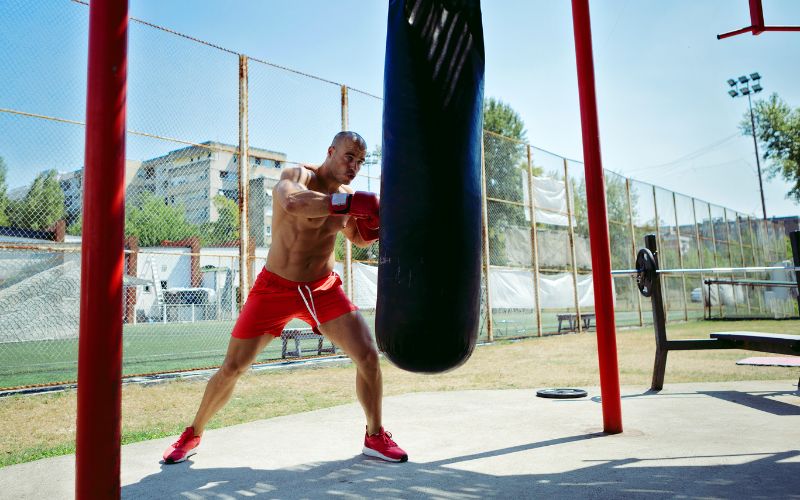
Being flat footed, where you keep your feet planted, can bring a number of benefits. Firstly, it allows for greater power generation in your punches. The stability provided by this stance, combined with a proper hip rotation and full extension, can lead to a significant force being packed into each punch.
The flat footed stance also provides better balance, which can come in handy when throwing longer combinations. This can enhance your ability to work well inside close quarters. Furthermore, another significant advantage is energy conservation. A flat footed boxer tends to expend less energy, enabling them to save up for longer bouts.
However, the flat footed stance is not without its drawbacks. Punches thrown from the outside tend to be slower due to the lack of momentum from the feet. Moreover, the biggest drawback is the increased reliance on head movement and reaction for defense. This could be risky as it means you’re always within your opponent’s range, making evasive action more difficult.
The Pros and Cons of Being On Your Toes
On the flip side, being on your toes offers a different set of advantages. The standout benefit is the improved defensive capabilities provided by enhanced footwork. When you’re on your toes, you can easily step in and out of your opponent’s range, making it easier to dodge punches and counterattack.
Additionally, being on your toes allows for faster punching, as demonstrated by boxers like Manny Pacquiao. This stance facilitates moving in and out swiftly, enabling quick strikes. Not to mention, it also aesthetically looks better, giving the impression of a more agile and ready fighter.
However, being on your toes also has its own set of cons. It’s more energy-consuming, which means boxers need excellent conditioning to maintain this stance throughout a fight. Another drawback is that your punches might lack the power seen in a flat footed stance. Lastly, there’s the potential issue of balance, as constant movement might disrupt your stability, especially when throwing punches.
Mastering Both
So, which stance should a boxer practice more? The answer is a bit of both. However, it is advisable to focus more on being on your toes due to its difficulty and the benefits it offers in defense and speed. Once you master moving in and out swiftly, throwing fast punches, and maintaining balance, you can then work on harnessing the power and stability advantages of being flat footed.
Remember, footwork is the cornerstone of boxing. Without good footwork, a boxer’s overall performance could suffer. Many of the sport’s greats have showcased impeccable footwork, a testament to its importance in the ring. Therefore, mastering both stances – being flat footed and being on your toes – can help create a well-rounded boxer, capable of adapting to different fight scenarios.
Should Your Heels Touch The Ground When Boxing?
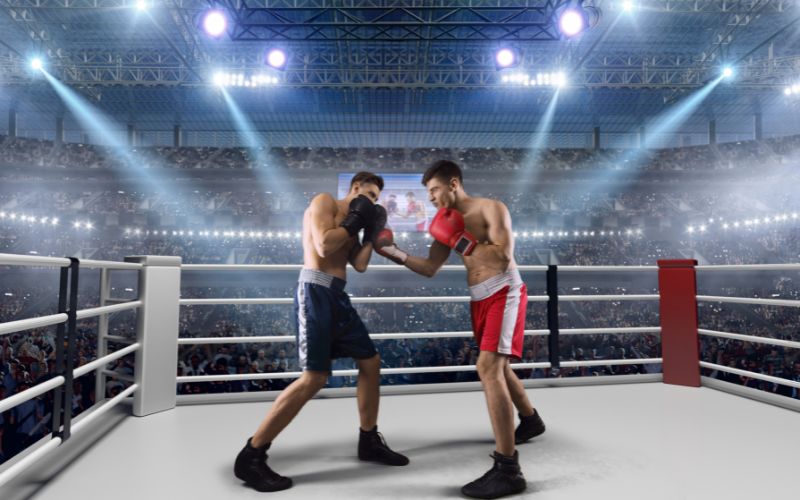
The question of whether your heels should touch the ground when boxing depends on the context and your chosen fighting style. As discussed in the previous sections, both being flat footed and being on your toes offer unique advantages and disadvantages.
In a general sense, boxers are often taught to stay on the balls of their feet for agility and quick movement. This stance, where the heels are lifted slightly off the ground, allows for more dynamic movement, facilitates better defense, and enables faster punches. It provides the ability to swiftly move in and out of your opponent’s range, dodge punches, and counterattack with speed.
However, this does not mean your heels should never touch the ground. In fact, there are instances where having your feet – and by extension, your heels – flat on the ground can be beneficial.
When you need to generate power – for instance, during a heavy combination or a knockout attempt – planting your feet firmly on the ground, heels included, can be beneficial. This flat footed stance enables greater stability and power transfer from the ground through your body and into your punch.
Additionally, if you’re working inside or maintaining a certain position in the ring to save energy, having your heels touch the ground can improve your balance and stability.
However, being flat footed for prolonged periods can make you a more predictable and easier target. Therefore, it’s crucial to balance your stance based on the situation in the ring, adjusting your footwork and weight distribution as necessary.
Should Feet Be Planted When Punching?
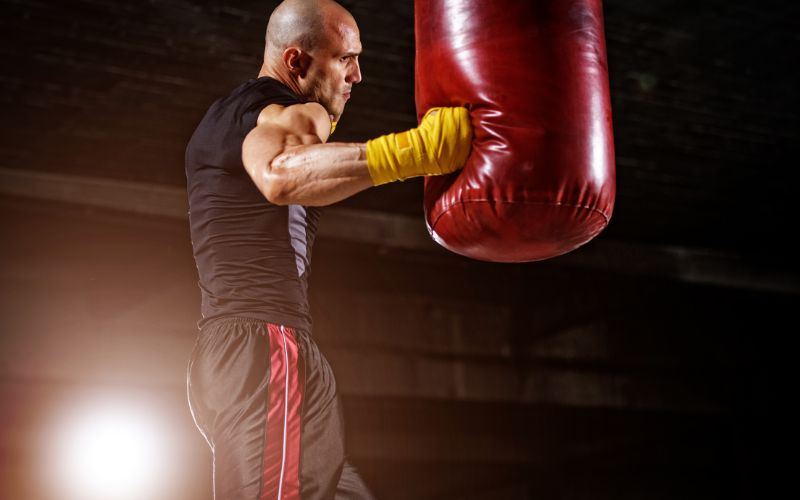
The position of your feet during a punch can significantly influence its effectiveness, especially in terms of power and balance. However, the answer to whether your feet should be planted when punching isn’t a simple yes or no. It depends on the type of punch you are throwing and the specific situation in the boxing match.
When you’re aiming to deliver a powerful punch, having your feet firmly planted on the ground can be beneficial. This is because a strong punch doesn’t come from the arm alone; it relies heavily on generating power from the ground up, starting with the feet, through the rotation of the hips, and finally, into the extension of the arm.
Planting your feet allows for maximum power transfer from the ground, providing the stability needed to generate forceful punches without losing your balance.
Moreover, during close-range or inside fighting, where speed isn’t the highest priority, keeping your feet planted can help maintain balance, control, and the ability to deliver hard hits.
On the other hand, staying light on your feet, mainly on the balls of your feet, can be beneficial in different scenarios. Quick jabs, fast combinations, or situational punches often require you to be mobile and reactive, allowing you to get in, strike, and get out swiftly. In these cases, keeping your feet ready to move rather than firmly planted helps to increase your speed and agility.
So, the decision to plant your feet or not depends largely on the situation, your strategy, and the type of punch you’re throwing. The key is to maintain a good balance between power and mobility.

